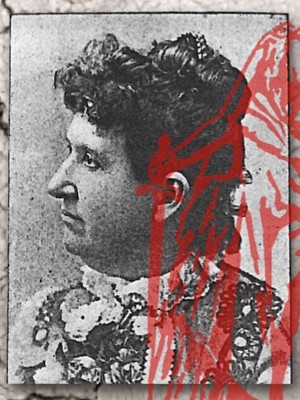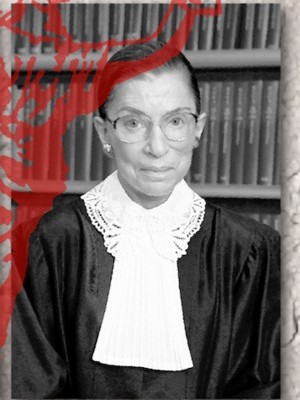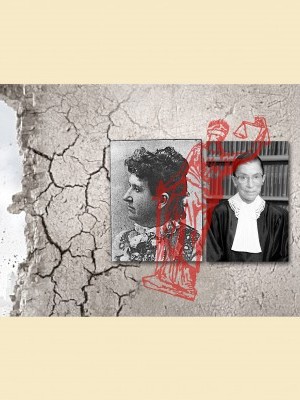Nora Alvarez Ahdab
Lycée Français de New York | New York, NY | 9th Grade
HISTORICAL FIGURE I ADMIRE
Ada Kepley
Throughout most of American history, women’s lives in a majority of states were limited by common law that had been brought to North America by English colonists. These laws were mostly about marriage and property and they specified that a married woman did not have a separate legal existence from her husband. A feme covert or a married woman, had the same legal importance as an uderage child or a slave. In fact, she couldn’t own property in her own name or control her own earnings, except under very special circumstances. And when the husband died, the wife wasn’t able to be the guardian to their under-age children. However, widows did have the right of "dower," they also had a right to property they brought into the marriage as well as to life usage of one-third of their husbands’ estate. And though a married woman was not able to sue or sign contracts by herself, her husband often did need her consent before he sold any property his wife would have inherited.
As time went by, women started realizing how many things they were being restricted from, and some even started to rebel against these restrictions. This started the first wave of feminism.
Ada Kepley, born in 1847, was part of this first wave. She was the first female to graduate with a law degree and practice in a court of law in the U.S. She graduated in 1870 with a law degree, from what is today Northwestern University School of Law. Even after obtaining her law degree, she was prohibited from legal practice by state law. This law denied women licence to the "learned professions" like law, medicine and theology. In 1881 the Illinois law was overturned and Kepley was granted the right to practice. But by then, she had become less of a lawyer and more of an advocate for women's suffrage and temperance (movement against the consumption of alcoholic beverages). She said: “I work as hard as a man . . . I earn money like a man. I bear the burdens of community like a man. I am robbed as a woman! I have no voice in anything or in saying how my money, which I have earned, shall be spent. The men of Illinois and the United States run their hands into my pockets, take out my hard earned money, and say impertinently, "What are you going to do about it, you can't help yourself". Ada Kepley went on to work with numerous women’s associations, notably the Equity Club, which supported women pioneers in the legal profession. Ada Kepley became one of the most important figures in the history of women in law. Like Annette Abbott Adams, first woman to be the Assistant Attorney General in the United States, Florence Ellinwood Allen, first woman to serve on a state supreme court, Helen Elsie Austin, who was among the first African Americans admitted to the practice of law in the United States, and Ruth Bader Ginsburg.
CONTEMPORARY FIGURE I ADMIRE
Ruth Bader Ginsburg
Ruth Bader Ginsburg, born in 1933, became the second female justice of the U.S. Supreme Court in 1993. Ginsburg served as the director of the Women’s Rights Project of the American Civil Liberties Union during the 1970s, and became the first female tenured professor at Columbia university in 1972. In 1980, she was appointed to the U.S. Court of Appeals for the District of Columbia. But despite her outstanding academic record, she continued to encounter gender discrimination while seeking employment after graduation. Ruth Bader Ginsburg believed that the law was gender-blind and all groups were entitled to equal rights. She once said: “Women will only have true equality when men share with them the responsibility of bringing up the next generation”. One of the five cases she won before the Supreme Court involved a portion of the Social Security Act that favored women over men because it granted certain benefits to widows but not widowers. Once named to the U.S. Supreme Court, Ruth Bader Ginsburg continued to fight against gender discrimination. In 1996, Ginsburg wrote the Supreme Court’s landmark decision in United States v. Virginia, which said that the Virginia Military Institute could not refuse to admit women. In 1999, she won the American Bar Association’s Thurgood Marshall Award for her contributions to gender equality and civil rights. To this day, we can consider her, as well as Ada Kepley and the other women mentioned, as important lawyers who have made an indent in the history of law, and have paved the way for women in law today.
What the Project Means to Me
About my artwork –
In this piece, the two figures against a chipping wall represent the walls they have “broken” down. The graffiti of lady justice served as a tool to tie both women together; both of them have the pursuit of justice in common, because they are lawyers but also because they are women in a male-dominated field. I'd love to be a lawyer.
Explore the Archive
Deadline Extended
There's still time to join Women Leading the Way.
Become a part of our storytelling archive. Enroll your class today.
Join the Project



